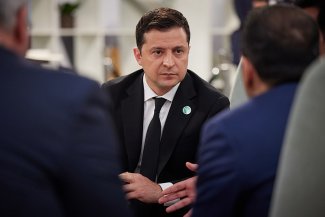The power of keeping calm. Ukraine in the face of Russia’s potential aggression

In its public message, the government in Kyiv has cautiously assessed the threat of Russian aggression. It has, though, been simultaneously appealing to the West to increase military aid and to impose severe sanctions on Russia. The topic of a possible war has dominated Ukraine’s politics and media. President Volodymyr Zelensky in his addresses to citizens on 20 and 25 January warned against panic, which he said was the goal of Russian propaganda. Representatives of the command of the Ukrainian armed forces, the Minister of Defence and the Prime Minister have provided assurances about the resilience of the country’s economy as well as the country’s readiness to defend itself. It primarily relies on the army and territorial defence forces.
Active engagement has also been demonstrated by local government representatives, including by the mayors of the key cities located near the northern border and Vitaly Klitschko, the mayor of Kyiv, and Ihor Terekhov, the mayor of Kharkiv. The Board of the Association of Ukrainian Cities will meet in Kyiv on 28 January. During the meeting, representatives of the oblasts and cities will discuss the state of the defence preparations. The public seems determined to defend the country but, in the opinion of the majority, the government is not making enough efforts to prevent a Russian armed attack.
Commentary
- Most likely, the government is making such reassuring statements not because it believes that an invasion is highly probable but rather because it fears an outbreak of war hysteria among citizens. Announcements of this kind are aimed at improving the Ukrainian public’s resilience to Russian disinformation and at preventing an economic crisis (the fall in the value of the hryvnia, an increase in inflation and the cost of refinancing debt in the financial markets, etc.). Kyiv’s clear scepticism regarding Moscow’s readiness to launch a large-scale rapid military operation contrasts with the statements made by Ukraine’s Western partners. This is due to the fact that the Ukrainian government primarily wants to reassure its residents by highlighting the Kremlin’s psychological and informational moves, and thus to neutralise them. It also wants to impose its own political message, different than the sometimes alarmist appeals of a section of the opposition gathered around the former president Petro Poroshenko. Another reason for this contrast is the publicly emphasised fact that Ukrainians are used to functioning in a state of permanent threat from Russia, as well as the ongoing war in Donbas and aggressive hybrid moves made by Moscow on a regular basis.
- Kyiv’s efforts are focused on persuading Western countries to impose sanctions targeting Russia even before it stages an attack to effectively discourage it from doing so. The Ukrainian government has been trying to use Moscow’s actions to gain stronger support from the West. This concerns both political support (it is arguing that NATO membership would be the only effective means of counteracting Russian aggression) and military support (focusing on efforts to gain access to supplies of new weapons and increasing the presence of NATO forces in the country’s airspace and in the Black Sea). These efforts have brought some results. However, it seems that they are primarily an effect of the growing awareness in the EU and NATO of the inevitability of a Russian attack, which is conducive to the consolidation of a common position and determination to take real steps to contain Moscow.
- The credibility of Ukrainian lobbying in the West is undermined by the moves the governing party has made on the domestic political scene. Despite voices from the Western partners pointing to the counterproductive nature of deepening internal divisions, Zelensky has not given up his struggle with the oligarchs and political opponents: in November he accused Rinat Akhmetov, the country’s richest and most influential oligarch, of participating in a planned coup d'état, and in December an investigation was launched against Poroshenko on charges of high treason and supporting terrorist organisations. These actions may provide evidence that the Russian threat has been underestimated and is being used to settle scores on the domestic political scene.
- In recent days, the message about the low probability of an invasion has been accompanied by an increased media presence of high-ranking state officials responsible for the country’s defence claiming that Ukraine is ready to resist Russia. The main emphasis – apart from the military capabilities of the armed forces being greater than in 2014 – has been placed on the Territorial Defence Forces (TDF) and public military mobilisation (encouraging people to join voluntary TDF formations and allowing women to be mobilised on a larger scale). Given the obvious disproportion in the personnel and equipment of the regular forces of the two countries’ armies, Kyiv is counting on the effectiveness of civil resistance, in line with Ukraine’s Defence Plan which was approved last October in the event of an outbreak of a full-scale military conflict with Russia. Due to this, the army, currently numbering over 260,000 people (including 11,000 in TDFs), in the case of war may count on the support of 300,000–400,000 volunteers. Most of them have combat experience acquired during the fighting in the east of the country since 2014.
- The fact that Ukrainians are counting on ‘national resistance’ is also visible in the polls. According to the public opinion polls carried out in January, almost half of respondents viewed the threat of Russian aggression as real, and in a December poll one in three of them declared their readiness for active (armed) resistance in the event of an armed conflict with Russia, and over 20% declared their readiness for civil resistance and participation in demonstrations. The public mobilisation to fight is high: anti-Russian protests are taking place, and there are signals from various regions of the country that civilians are widely involved in military training and grassroots initiatives of this kind.




